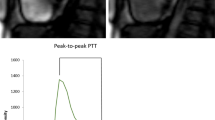Abstract
Pulmonary transit time (PTT), defined as the time taken for a contrast agent bolus to pass from the right ventricle to the left ventricle, is a surrogate for non-invasive assessment of preload. It is used in several imaging modalities: pulmonary angiography, echocardiography and cardiac magnetic resonance (CMR). Many recent studies have highlighted the prognostic value of PTT. Therefore, we sought to evaluate PTT in a consecutive cohort of patients undergoing CMR. We retrospectively evaluated PTT normalised for heart rate in 278 patients (66% male, mean age 58 ± 11 years) who underwent CMR between August 2017 and November 2021 with a diagnosis of dilated cardiomyopathy, infarct, hypertrophy, valvular, myocarditis, other pathology or no pathology (“normal”). Normalised pulmonary transit time (nPTT) was higher in men than in women (8.4 ± 1.3 beats vs 7.5 ± 1.1 beats, p = 0.002) in the “normal” group. nPTT was moderately correlated with left ventricular end-diastolic volume (LVEDV) (r2 = 0.19; p < 0.001), left ventricular end-systolic volume (LVESV) (r2 = 0.34; p < 0.001) and left ventricular ejection fraction (LVEF) (r2 = 0.29; p < 0.001). nPTT was significantly higher in patients with dilated cardiomyopathy (11.3 ± 5.4 beats; p < 0.001), infarct (9.5 ± 2.9 beats; p < 0.001) or valvular heart disease (9.5 ± 3.1 beats; p = 0.006) than in patients included in the “normal” group (7.9 ± 1.3 beats). The nPTT is an important marker of pathology. Its value depends on sex and type of pathology, but it is not specific for any type of pathology.






Similar content being viewed by others
References
Gödje O et al (1998) Central venous pressure, pulmonary capillary wedge pressure and intrathoracic blood volumes as preload indicators in cardiac surgery patients. Eur J Cardio-Thorac Surg. 13:533–539 (discussion 539-540)
Lancellotti P et al (2017) Echo-Doppler estimation of left ventricular filling pressure: results of the multicentre EACVI Euro-Filling study. Eur Heart J Cardiovasc Imaging 18:961–968
Nauta JF et al (2018) Correlation with invasive left ventricular filling pressures and prognostic relevance of the echocardiographic diastolic parameters used in the 2016 ESC heart failure guidelines and in the 2016 ASE/EACVI recommendations: a systematic review in patients with heart failure with preserved ejection fraction. Eur J Heart Fail 20:1303–1311
Goedje O, Seebauer T, Peyerl M, Pfeiffer UJ, Reichart B (2000) Hemodynamic monitoring by double-indicator dilution technique in patients after orthotopic heart transplantation. Chest 118:775–781
Kumar A et al (2004) Pulmonary artery occlusion pressure and central venous pressure fail to predict ventricular filling volume, cardiac performance, or the response to volume infusion in normal subjects. Crit Care Med 32:691–699
Huber W et al (2008) Volume assessment in patients with necrotizing pancreatitis: a comparison of intrathoracic blood volume index, central venous pressure, and hematocrit, and their correlation to cardiac index and extravascular lung water index. Crit Care Med 36:2348–2354
Ricci F et al (2018) Prognostic value of pulmonary blood volume by first-pass contrast-enhanced CMR in heart failure outpatients: the PROVE-HF study. Eur Heart J Cardiovasc Imaging 19:896–904
Houard L et al (2021) Prognostic value of pulmonary transit time by cardiac magnetic resonance on mortality and heart failure hospitalization in patients with advanced heart failure and reduced ejection fraction. Circ Cardiovasc Imaging 14:e011680
Troger F et al (2021) Cardio-pulmonary transit-time by cardiac magnetic resonance imaging: associates to infarct severity and adverse events after reperfused STEMI. Eur Heart J Cardiovasc Imaging. https://doi.org/10.1093/ehjci/jeab090.062
Seraphim A et al (2021) Prognostic value of pulmonary transit time and pulmonary blood volume estimation using myocardial perfusion CMR. Jacc Cardiovasc Imaging 14:2107–2119
Seraphim A et al (2021) Comparison of the prognostic value of stress and rest pulmonary transit time estimation using myocardial perfusion CMR. Eur Heart J Cardiovasc Imaging. https://doi.org/10.1093/ehjci/jeab090.017
Victorica BE, Gessner IH (1975) A simplified method for quantitating left-to-right shunts from arterial dilution curves. Circulation 51:530–534
Mischi M et al (2009) Intra-thoracic blood volume measurement by contrast magnetic resonance imaging. Magn Reson Med 61:344–353
Herold IHF et al (2016) Reliability, repeatability, and reproducibility of pulmonary transit time assessment by contrast enhanced echocardiography. Cardiovasc Ultrasound 14:1
Guo X et al (2022) First-pass perfusion cardiovascular magnetic resonance parameters as surrogate markers for left ventricular diastolic dysfunction: a validation against cardiac catheterization. Eur Radiol 32(12):8131–8139
Martin YN, Pabelick CM (2014) Sex differences in the pulmonary circulation: implications for pulmonary hypertension. Am J Physiol Heart Circ Physiol. 306:H1253–H1264
Funding
This work was not supported by any funding.
Author information
Authors and Affiliations
Contributions
AJ and RG wrote the main manuscript text and prepared figures. All authors reviewed the manuscript
Corresponding author
Ethics declarations
Competing interests
The authors declare no competing interests.
Additional information
Publisher's Note
Springer Nature remains neutral with regard to jurisdictional claims in published maps and institutional affiliations.
Supplementary Information
Below is the link to the electronic supplementary material.
Rights and permissions
Springer Nature or its licensor (e.g. a society or other partner) holds exclusive rights to this article under a publishing agreement with the author(s) or other rightsholder(s); author self-archiving of the accepted manuscript version of this article is solely governed by the terms of such publishing agreement and applicable law.
About this article
Cite this article
Jossart, A., Gerber, B., Houard, L. et al. Distribution of normalized pulmonary transit time per pathology in a population of routine CMR examinations. Int J Cardiovasc Imaging 40, 149–156 (2024). https://doi.org/10.1007/s10554-023-02976-x
Received:
Accepted:
Published:
Issue Date:
DOI: https://doi.org/10.1007/s10554-023-02976-x




